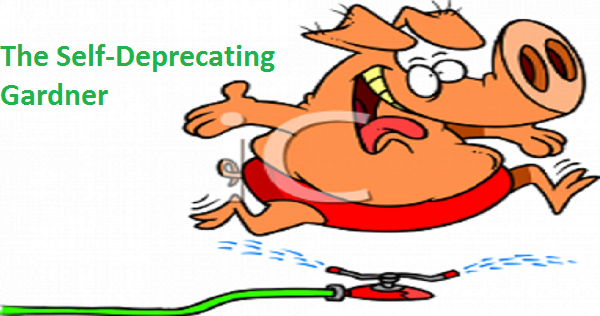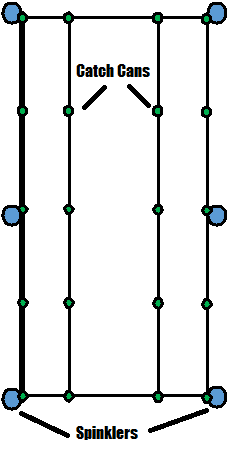
This Spring, the Self-Deprecating Gardner in conjunction with Liberty Park Press will offer a series of irrigating tools and tips that will hopefully help to improve the health of plants and save money on the Summer watering bill. This tutorial is geared towards the homeowner and the DIY enthusiast.
In our previous column, we made a valiant attempt to explain and summarize the loaded and complex concept of Evapotranspiration (ETc) and illustrate that water loss is based on multiple factors. We will also introduced the effective tool of the Landscape Factor (KL) in refining ET to the custom and specific settings of a landscape based on terrain, plant species and plant density, with the final product as Plant Available Water (PWR). This week, we will show how the concepts of PWR and Allowable Depletion or AD combined to produce an accurate range between irrigation events based on soil, plant and meteorological factors. Finally, we will highlight the basics of sprinkler performance testing in specifying run times based on soil moisture content.
The constituents of Allowable Depletion (AD), include the soil type, depth of plant root zone and Management Allowable Depletion (MAD) magnitude. While ET and PWR illustrates the transfer of heat flux ener gy through temperature, humidity, solar radiation, wind speed and air pressure, combining AD and PWR can be likened to the orgiastic fusion between peanut butter and chocolate. The equation is simple and the results are eloquent. By dividing AD into PWR, one can produce the basic range for an effective and efficient irrigation schedule. We will use the following example to show the method for finding the Irrigation Interval or IN based on historical data. Our Portland, Oregon lawn is located on the side of a home in loam soil with a 5 inch root zone. The AD for the turf is .43 based on the following: .17 AW of loam x 5inch RZ= .85in/in AND .85in/in x 50% MAD= .43in. The average PWR for a July day is .19 inches based on a KL of .8. To calculate the IN, use the following equation- .43 AD / .19 PWR = 1.7 and round up= 2 days IN. Thus, taking into account all of the plant, landscape and weather factors, if the turf is losing nearly .25 inches of water per day, scheduling watering events every other day in this example would sustain aesthetic appearance and good plant health. The IN range is flexible and can be modified to account for daily fluctuations in PWR due to changes in weather conditions, most notably with the onset of a heatwave or rain events. Further calculations for IN are required in producing specific run times and this concept will be covered in the next column. Before, the basis of micro-scheduling can be introduced, understanding the importance of sprinkler performance testing is required.
The first law of irrigation states that “all sprinkler systems are not created equal” and this holds true due to the underlying free market principles and differing skill-sets of private contractors installing a wide assortment of products serving an array of microclimates. The resulting chaos demands the implementation of system testing and efficiency standards tailored to account for the unique factors. There are three recognized measurements of performance efficiency recognized by the Irrigation Association, in attempting to create as basis for standards amid the reality of endless variables. However, we will focus on just one of the concepts, Distribution Uniformity or DU, as it is a simple and proven method of attaining a clear picture of how well the irrigation system is functioning and provides valuable data in modifying run times. DU simply establishes a performance score for a sprinkler zone by measuring the level of uniformity in how water interacts with the landscape. The primary application is for turf, as the majority of watering season resources is utilized in sustaining the appearance of grass. Calculating DU requires the facilitation of system testing and is the perfect opportunity to gain a comprehension into some of the basic engineering dynamics of sprinkler head designs.
In order to orchestrate a proper assessment of a single sprinkler station, the “catch-can test” is an easy way to attain instantaneous and valuable results, as a series of catchment devices are place in uniformity around the specific area being irrigation. The devices can be any item that can capture water, however the requirement is that they are all the same size and dimensions. Sanctioned “catch-can” models used by the professionals can be purchased online or out various regional irrigation distributors.
To test our example landscape in Portland, Oregon, we are going to determine the DU for an area of turf, 20 feet by 10 feet and served by six- 4 inch pop-ups with a 12 foot spray arc. The following image of a grid of 20 separate catchment devices would provide an adequate sample size of the spray head performance and adheres to the testing guidelines set by the Irrigation Association. “Catch Cans” should be  placed at every sprinkler and approximately halfway in between and multiples of four in figuring the average lowest quarter amount. (complete specifications are available at the Irrigation Association website). Since the 12 foot sprays overlap, we are measuring the extent of the uniformity of the coverage to gain a more precise resolution of accuracy. After the “catch-cans” are placed it is recommended that the station is run manually for at least 5 minutes. The test should be cancelled if sustained winds exceed 5 miles per hour as spray arcs will be comprised.
placed at every sprinkler and approximately halfway in between and multiples of four in figuring the average lowest quarter amount. (complete specifications are available at the Irrigation Association website). Since the 12 foot sprays overlap, we are measuring the extent of the uniformity of the coverage to gain a more precise resolution of accuracy. After the “catch-cans” are placed it is recommended that the station is run manually for at least 5 minutes. The test should be cancelled if sustained winds exceed 5 miles per hour as spray arcs will be comprised.
For our hypothetical Portland scenario, we choose to run the zone for 5 minutes and take subsequent measurements at the end of the test in millimeters or by multiplying inches by 16.387 to achieve the proper conversion. The following is a complete overview of the test results and calculated DU. The calculations are quite straightforward, simply add up the measurements and divide by the number of “catch-cans” to get the Catch Can Average or CAVG. To determine the DU, take the Lowest Quarter Average or DULQ, in this case the five lowest measurements and divide by the CAVG- DULQ / CAVG = DU. Our turf laboratory receives a moderate to low score of 65% which means that the uniformity from the spray heads in achieving proper effectiveness and coverage can be improved through adjustments to the arcs and minor repairs to the heads themselves. The source for the mediocre efficiency score could range from simple wear and tear to the actual sprinkler being tilted due to plant growth or soil shift. The industry standard for a solid DU is 75%, which means that in considering a feasible adjustment, an additional 25% of runtime would be required to compensate for the difference in performance uniformity. This management decision is completely at the discretion of the decision maker.
In our Portland example, if the station runtime was set to 20 minutes before “Catch-Can” testing than it would be logical to consider a 35% time increase to account for the mediocre system performance. Thus, the 20 minutes would be multiplied by the difference in uniformity (100/65= 1.538) to garner an adjusted runtime of 31 minutes.
Irrigation Interval and Distribution Uniformity are two crucial aspects in building an irrigation schedule that is based on the many environmental factors and the strengths and limitations of the local irrigation infrastructure. Mastering these concepts will help to facilitate a better understanding of the watering requirements of a landscape and gain an increased awareness as to the capabilities and nuances of the sprinkler system.
In our next column, we will introduce Net Precipitation Rate (PRnet) in determining specific runtimes for zones and the basics of water budgeting.
Appendix
Plant Available Water (PAW): Available Water x Root Zone inches = PAW: AW x RZ= PAW
Allowable Depletion (AD): PAW x Management Allowable Depletion= AD: PAW x AD= AD
Evapotranspiration (ETc)
Landscape Factor (KL)= Species Factor x Microclimate Factor x Density Factor= KL: Ks x Kmc x Ks= KL
Plant Water Requirement (PWR): ETc x KL= PWR
Irrigation Interval (IN): AD/PWR= round up or down IN days
Distribution Uniformity (DU): Lowest Quarter Catch Can Average/ Catch Can Average= DU: DULQ/CAVG= DU